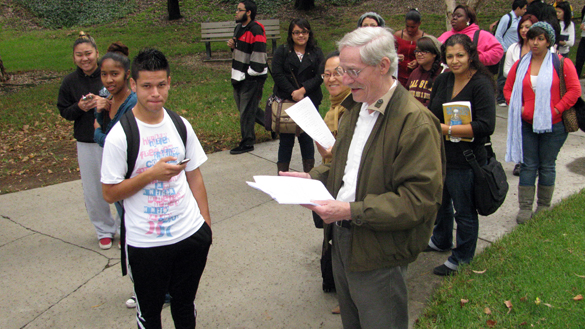From students who dutifully trooped out to the Sculpture Garden to designated staff members who were responsible for evacuating campus buildings, the CSU Dominguez Hills community participated in a statewide earthquake drill, the “Great California Shakeout,” on Oct. 20. Approximately 8.6 million Californians took part in the exercise, which was enacted by residents, businesses, and public agencies throughout the state.

The Shakeout exercise was helpful in not only assuring that students, faculty, and staff at CSU Dominguez Hills are ready for an earthquake, but to identify areas where the campus may not be completely ready. Campus “floor wardens” like Kim Barras were instructed to evacuate their buildings at the appointed time of 10:20 a.m. and were able to pinpoint where additional methods of communication are needed.
“I am located in the East Academic Complex (EAC) where there are several one-story buildings,” said Barras, an administrative analyst for the School of Education (SOE). “I can only clear my building, we are not to go out of one building and into another. In a real earthquake it would be difficult to make sure everyone is out of the buildings since again, I cannot go back into another building.
“I cleared my building and stood outside and directed others to the evacuation site,” she said. “Most of the EAC are offices and we don’t have speakers inside to notify of an emergency. I think we could use a speaker nearer to the complex.”
Students, whether on- or off- campus, are informed of drills – and real emergencies – via a loudspeaker system that runs through the telephones in each classroom. In addition, they are notified via their my.csudh accounts with voicemail, email, and text messaging in the case of an emergency or disaster. Gary Singer, emergency management/preparedness coordinator, said that having updated contact information on each student is critical in a real or mock emergency.
“There are times when we would want to do a surprise evacuation, but this was not that time,” Singer said. “For this drill, we wanted to make sure that everyone was aware of the evacuation beforehand. So, leading up to the drill we issued reminders through multiple channels, including our ToroAlert mass notification system. However, not everyone has updated their my.csudh account to include their cell phone number. I strongly encourage everyone on campus to update their contact info on my.csudh so that, in the event of a disaster, we can deliver up-to-date information about the emergency.”
Cindy Aguilar, a junior majoring in child development, was in her English class in La Corte Hall when the Shakeout took place. She said that she was prepared to take part in the exercise before it occurred after receiving an email and voicemail on her cell phone, and felt safer knowing that the university was very proactive about informing students. Her professor, Burckhard Mohr, led his students to their designated area in the Sculpture Garden, and continued to return a graded assignment to them before dismissing class for the day.
Singer said that knowing what to expect from an earthquake before it strikes is important.
“Large earthquakes can last several minutes before the shaking actually stops,” he said. “And [occupants] that are in multi-storied buildings can expect some swaying of the building even after the earthquake is over.”
Singer said that the greatest challenge in an emergency is the sheer amount of evacuees that have to be guided out of every building on campus.
“Our floor wardens are greatly outnumbered and require cooperation from evacuees,” he said. “This is why I am always on the lookout for new [volunteers] for the program. Some buildings have a healthy amount of floor wardens, but we definitely need more.”
Judy Radeke, who was responsible for the nearby Small College Complex, said she sent many emails to her buildings’ occupants in the main SOE building and they were well prepared for the drill. An administrative support coordinator for the Division of Graduate Education, she said that although the Shakeout exercise was optional, she hopes that the campus continues to enhance its emergency preparedness procedures.
“The Small College Complex (SCC) is very old and that worries me,” she said. “However, the advantage SCC is that it is only one floor. I don’t think we are fully prepared but we are heading in the right direction. Gary Singer is trying his best to get the campus prepared for a disaster but he does need more volunteers.”
“Gary is doing a great job of preparing the campus and getting the administration involved,” added Barras. “I’ve been on this campus for 16 years and this is the most that has been done for emergency preparedness that I can remember.”
In the event of an emergency, the university’s “primary concern is for the safety of the students, faculty and staff who are on campus,” said Brenda Knepper, director of University Communications and Public Affairs.
“The California Shakeout exercise provided invaluable training for our campus emergency operations team and good practice for the overall campus population,” said Knepper. “Whenever we do emergency preparedness exercises such as this one, even if it seems to go smoothly overall, we always discover procedures or communications measures that we can improve.”
Singer says that there is always more work to do to become better prepared for an emergency. He advocates for individual preparations for family and friends off-campus, so that students, faculty, and staff can concentrate on their own safety if caught in an emergency situation while on campus.
“Preparedness is not only an institutional effort, it is an individual effort,” said Singer. “The more individuals that can care for themselves in the aftermath of a major disaster, the easier the job becomes for the university.”